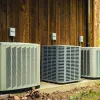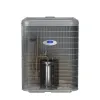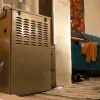We all love balance, right? You know… harmony, stability, uniformity. When anything is unbalanced – your checkbook, say, or even your daily schedule – it usually means something is wrong.
And when it comes to unbalanced indoor temperatures, that “something” is comfort.
Unbalanced temperatures create hot spots and cold spots throughout your home. In one room, you might be too cold. You adjust the thermostat to warm up, but then someone else feels too hot in a different room. It’s a frustrating HVAC catch-22.
There’s a common thread among most hot spot/cold spot problems.
Airflow. That’s usually the issue.
When you’ve got hot and/or cold spots, the problem typically has to do with one or more rooms not getting enough airflow from your HVAC system. Of course, there are different reasons why a particular area might not get enough airflow. Every case is different.
We often encounter this problem, typically defined as a temperature difference of more than four degrees among different rooms, when one or more of the following are true:
- Ducts and boots aren’t sized properly
- Ductwork is damaged, leaky, or poorly installed
- Ductwork is poorly designed or improperly balanced
- You’ve built an addition and you’re using your existing HVAC system to heat and cool the new space
But how do you diagnose the source of this problem in your house? And how do you fix it?
The simplest fix: add some airflow
No testing. No measurements. Minimal ductwork analysis. This solution involves adding a duct and an additional supply vent to the space that isn’t getting enough airflow. You can also just add a manual damper that blocks off (or partially blocks off) a room that’s getting too much air.
In a lot of cases, these types of fixes work just fine. But in other cases, well…
Adding airflow without testing anything can cause more problems than it solves.
For one thing, you need to ensure that your system has sufficient capacity to send air to the underserved area. If it doesn’t, adding airflow to a problem room might rob airflow from the rest of your house. You’ll solve one problem, but you’ll create new ones.
Even when the system does have enough capacity to provide proper airflow throughout the home, this fix might not work. Improper duct sizing or bad ductwork design can make it impossible to send air to the rooms where it’s needed.
The bottom line? Wantonly adding airflow to the problem area isn’t a foolproof solution.
Can it work? Sure. It often does. But there are numerous situations where it isn’t a good fix.
A better fix: measure and adjust
To fix temperature balance problems in a single room or area, this is the best course of action:
- Perform a room-by-room load calculation: This procedure, also known as a Manual J load calculation, tells you how much air each room should be getting.
- Measure how much air each vent blows: Using a digital hood, an HVAC professional (you know, guys like us) can determine how much air each supply vent is allowing into each room. Then we can compare that to the load calculation to figure out which areas need more air… and which need less.
- Identify sources of air infiltration: This part of the process doesn’t relate to HVAC and airflow specifically, but it’s often key to addressing the problem. Sometimes, no matter how well-designed your HVAC system is, you’ll still have hot and cold spots. If the issue has to do with air infiltration from gaps and cracks in the building envelope, a blower door test can help us determine where air leaks in and out of your home.
- Analyze insulation levels: Ditto for this part of the process. If you have inadequate or poorly installed insulation in certain areas of your home, that could make some rooms feel too hot or too cold at all times of the year.
- Perform a ductwork analysis: When the problem can be solved via HVAC adjustments (i.e. optimizing airflow), we’ll analyze your ducts to figure out the best way to deliver the right amount of air to the right rooms.
Whenever the load calculation results and the digital hood (airflow) results shake out a-ok, the problem is usually related to air leakage and/or insulation ‒ not airflow. Steps 3 and 4 of the above procedure address that issue, so you can target the real source of the problem instead of wasting your time with airflow adjustments.
Following the above steps involves a higher level of service and expertise than simply adding a supply register or a manual air damper. But it also mitigates the potential issues of thoughtlessly adding airflow by finding out how much air you need and where you can get it, all without causing additional comfort problems.
What if you built an addition?
A lot of builders will run ducts from your existing HVAC system to whatever addition they’re building for you. Sometimes this works. If the system has enough capacity to heat and cool another space without affecting the rest of your house, you’re good.
But other times, this “solution” steals too much air from the rest of your home, leaving you with hot spots and cold spots that you didn’t have before. Potential fixes include:
- Following the process outlined above: Check static pressure to see how much airflow is available for balancing throughout the home, including the new addition. After taking all the proper measurements, you can determine whether it’s possible to heat and cool the space with your current system.
- Adding a mini-split heat pump: Basically, you’ll uninstall the ducts and vents your builder put in. This will make your HVAC system perform the same as it did before you built the addition. Then you can add one or more mini-split heat pumps to the new room or rooms. Mini-splits are great solutions for large rooms and usually don’t require ductwork.
- Getting a bigger HVAC system: Another way to gain the capacity needed to heat and cool your addition is to get a newer, bigger HVAC system. Of course, you’ll need to perform a load calculation to determine which size is the right size. You don’t want to get one that’s too big, or else you’ll experience other problems.
The moral of the story? Balance is possible.
Unless you live in an uninsulated barn with holes in the roof, there’s almost always a way to make a hot room cool or a cold room warm! Sometimes, it’s as simple as adding some airflow. Other times, you’ll need a pro to take measurements and make informed recommendations.
The good news is that you can fix this problem. And the sooner you do, the sooner you’ll start feeling comfortable.






